#paul wakefield
Explore tagged Tumblr posts
Text






Mr. Wakefield's Crusade (1992) Episode 2
34 notes
·
View notes
Text




hbomb victim list grows everyday
#hbomberguy#james somerton#tommy tallarico#andrew wakefield#paul joseph watson#if ur new to hbombs content u should watch his other takedowns#the pjw saga was especially funny
83 notes
·
View notes
Text
Some Max Rebo for you
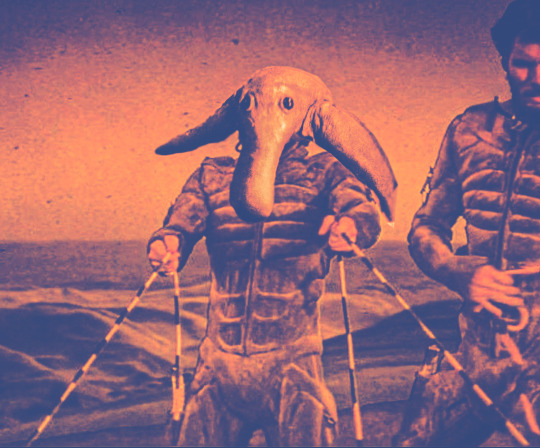
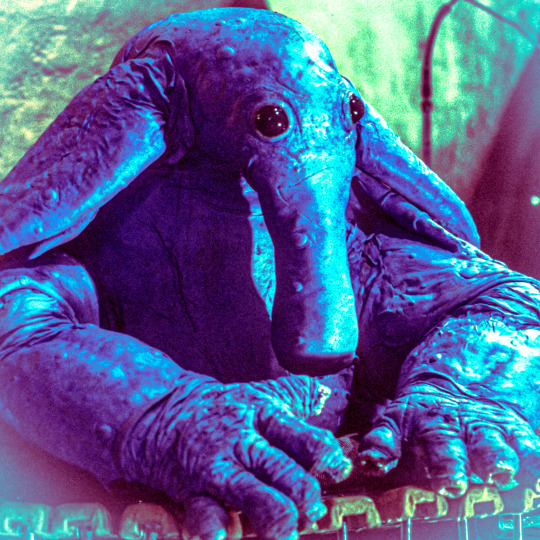



#Max rebo#the max rebo band#maxreboband#max rebo band#return of the jedi#rotj#star wars#episode VI#tommy makem and the clancy broters#tommy makem#clancy brothers#dune#paul atreides#worm#sand worm#shai hulud#boston#red sox#tim wakefield
22 notes
·
View notes
Audio
Sage Guyton, Jeremy Wakefield, Paul Tibbitt - Hey Mean Mr. Bossman
Plays in:
40a. "Squid on Strike"
#spongebob#spongebob squarepants#audio#music#spongebob original soundtrack#Squid on Strike#Hey Mean Mr. Bossman#Sage Guyton#Jeremy Wakefield#Paul Tibbitt
13 notes
·
View notes
Text
(Mostly) Lost, but Not Forgotten: Omar Khayyam (1923) / A Lover’s Oath (1925)

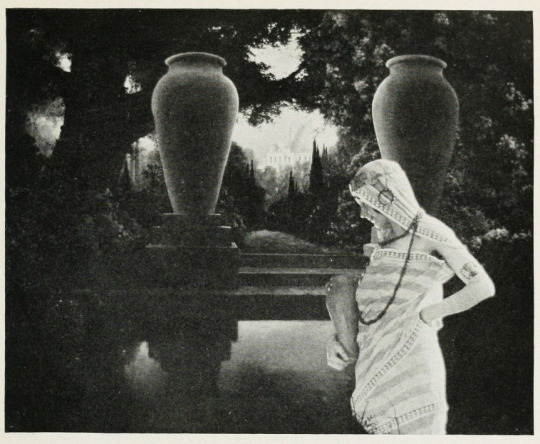
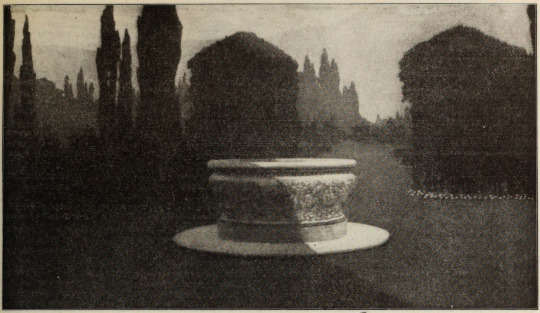

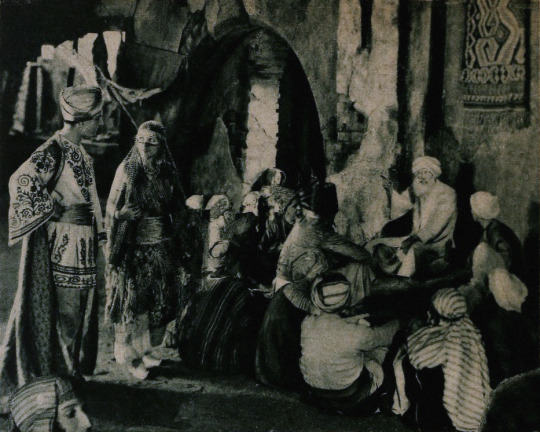


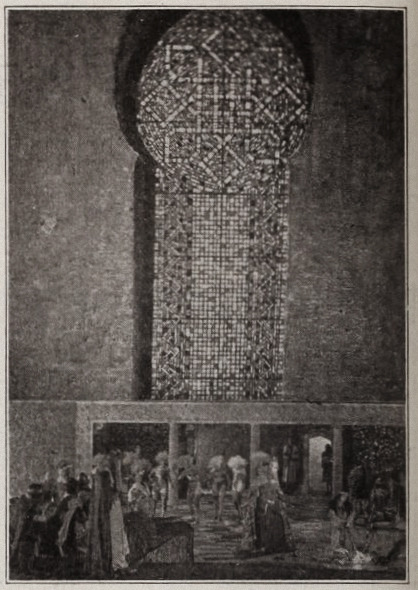
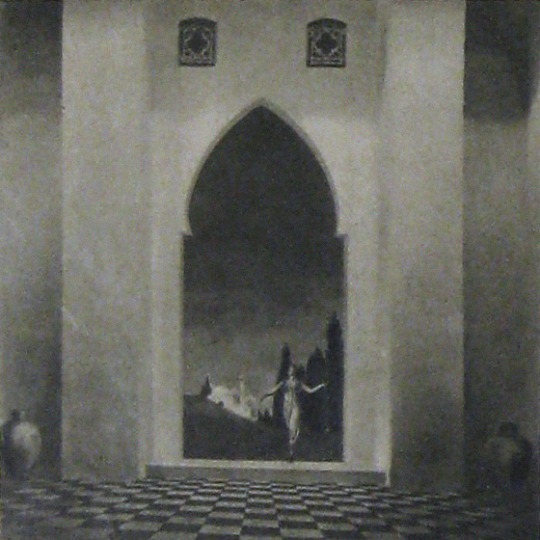
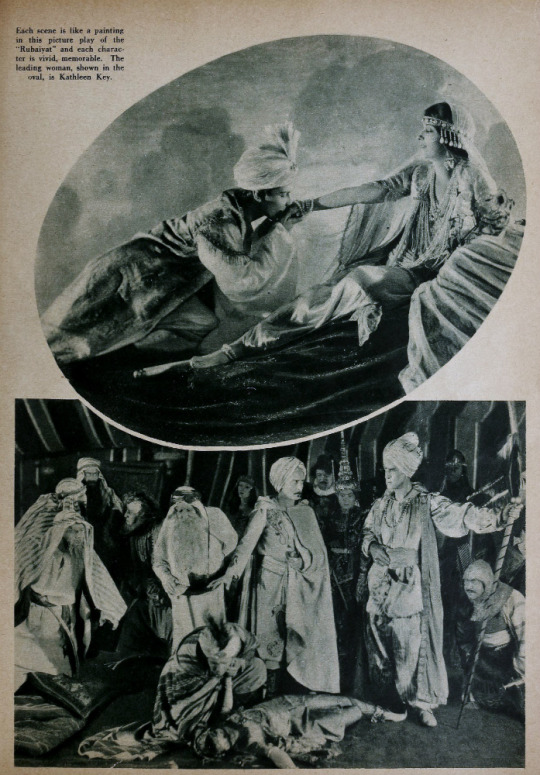
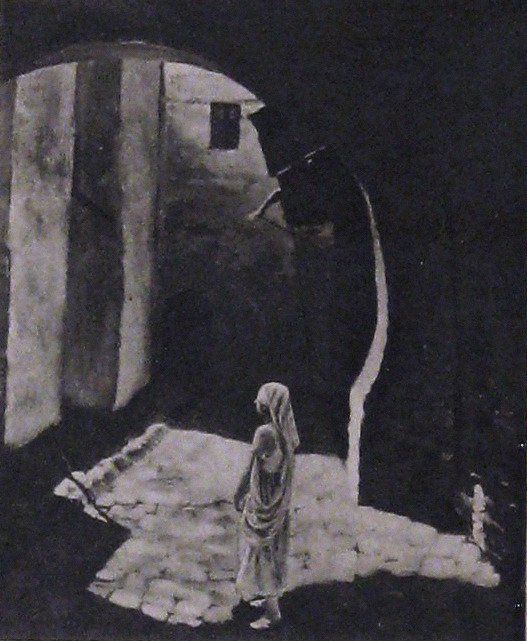

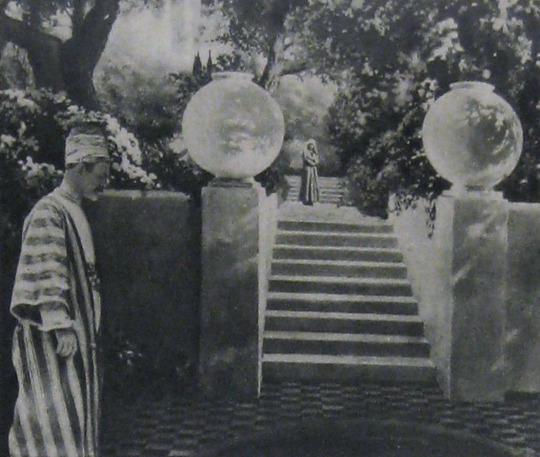
Alternate Titles: The Rubaiyat of Omar Khayyam, The Rubaiyat, Omar Khayyam, Omar
Direction: Ferdinand Pinney Earle; assisted by Walter Mayo
Scenario: Ferdinand P. Earle
Titles: Marion Ainslee, Ferdinand P. Earle (Omar), Louis Weadock (A Lover’s Oath)
Inspired by: The Rubaiyat of Omar Khayyam, as edited & translated by Edward FitzGerald
Production Manager: Winthrop Kelly
Camera: Georges Benoit
Still Photography: Edward S. Curtis
Special Photographic Effects: Ferdinand P. Earle, Gordon Bishop Pollock
Composer: Charles Wakefield Cadman
Editors: Arthur D. Ripley (The Rubaiyat of Omar Khayyam version), Ethel Davey & Ferdinand P. Earle (Omar / Omar Khayyam, the Director’s cut of 1922), Milton Sills (A Lover��s Oath)
Scenic Artists: Frank E. Berier, Xavier Muchado, Anthony Vecchio, Paul Detlefsen, Flora Smith, Jean Little Cyr, Robert Sterner, Ralph Willis
Character Designer: Louis Hels
Choreography: Ramon Novarro (credited as Ramon Samaniegos)
Technical Advisors: Prince Raphael Emmanuel, Reverend Allan Moore, Captain Dudley S. Corlette, & Captain Montlock or Mortlock
Studio: Ferdinand P. Earle Productions / The Rubaiyat, Inc. (Production) & Eastern Film Corporation (Distribution, Omar), Astor Distribution Corporation [States Rights market] (Distribution, A Lover’s Oath)
Performers: Frederick Warde, Edwin Stevens, Hedwiga Reicher, Mariska Aldrich, Paul Weigel, Robert Anderson, Arthur Carewe, Jesse Weldon, Snitz Edwards, Warren Rogers, Ramon Novarro (originally credited as Ramon Samaniegos), Big Jim Marcus, Kathleen Key, Charles A. Post, Phillippe de Lacy, Ferdinand Pinney Earle
Premiere(s): Omar cut: April 1922 The Ambassador Theatre, New York, NY (Preview Screening), 12 October 1923, Loew’s New York, New York, NY (Preview Screening), 2 February 1923, Hoyt’s Theatre, Sydney, Australia (Initial Release)
Status: Presumed lost, save for one 30 second fragment preserved by the Academy Film Archive, and a 2.5 minute fragment preserved by a private collector (Old Films & Stuff)
Length: Omar Khayyam: 8 reels , 76 minutes; A Lover’s Oath: 6 reels, 5,845 feet (though once listed with a runtime of 76 minutes, which doesn’t line up with the stated length of this cut)
Synopsis (synthesized from magazine summaries of the plot):
Omar Khayyam:
Set in 12th century Persia, the story begins with a preface in the youth of Omar Khayyam (Warde). Omar and his friends, Nizam (Weigel) and Hassan (Stevens), make a pact that whichever one of them becomes a success in life first will help out the others. In adulthood, Nizam has become a potentate and has given Omar a position so that he may continue his studies in mathematics and astronomy. Hassan, however, has grown into quite the villain. When he is expelled from the kingdom, he plots to kidnap Shireen (Key), the sheik’s daughter. Shireen is in love with Ali (Novarro). In the end it’s Hassan’s wife (Reicher) who slays the villain then kills herself.
A Lover’s Oath:
The daughter of a sheik, Shireen (Key), is in love with Ali (Novarro), the son of the ruler of a neighboring kingdom. Hassan covets Shireen and plots to kidnap her. Hassan is foiled by his wife. [The Sills’ edit places Ali and Shireen as protagonists, but there was little to no re-shooting done (absolutely none with Key or Novarro). So, most critics note how odd it is that all Ali does in the film is pitch woo, and does not save Shireen himself. This obviously wouldn’t have been an issue in the earlier cut, where Ali is a supporting character, often not even named in summaries and news items. Additional note: Post’s credit changes from “Vizier” to “Commander of the Faithful”]
Additional sequence(s) featured in the film (but I’m not sure where they fit in the continuity):
Celestial sequences featuring stars and planets moving through the cosmos
Angels spinning in a cyclone up to the heavens
A Potters’ shop sequence (relevant to a specific section of the poems)
Harem dance sequence choreographed by Novarro
Locations: palace gardens, street and marketplace scenes, ancient ruins
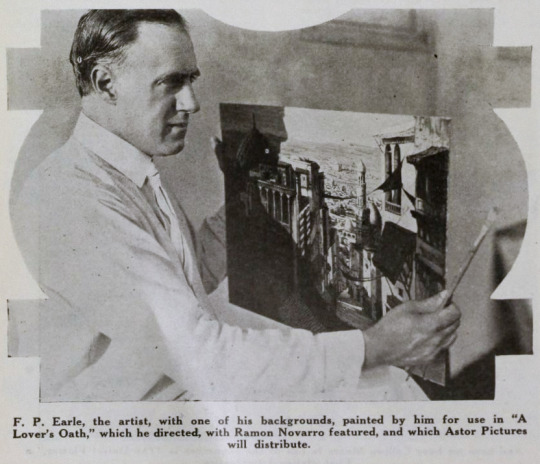
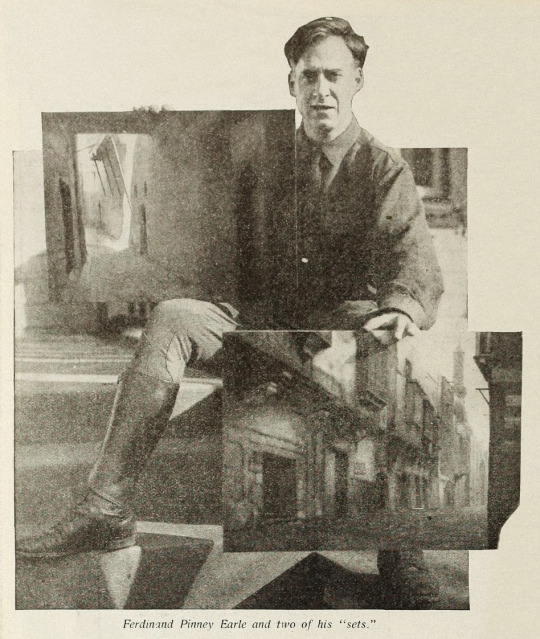
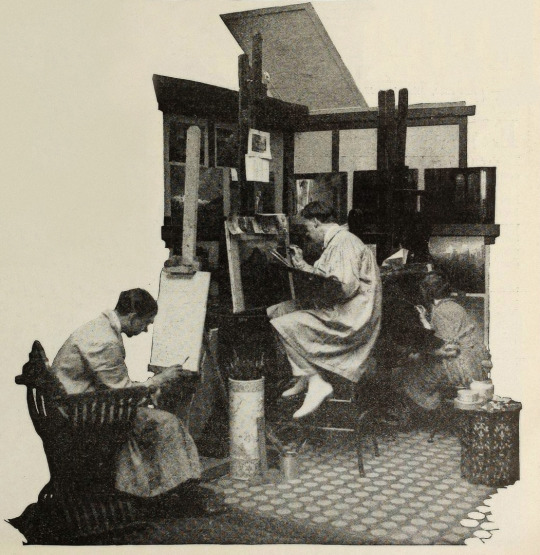


Points of Interest:
“The screen has been described as the last word in realism, but why confine it there? It can also be the last word in imaginative expression.”
Ferdinand P. Earle as quoted in Exhibitors Trade Review, 4 March 1922
The Rubaiyat of Omar Khayyam was a massive best seller. Ferdinand Pinney Earle was a classically trained artist who studied under William-Adolphe Bougueraeu and James McNeill Whistler in his youth. He also had years of experience creating art backgrounds, matte paintings, and art titles for films. Charles Wakefield Cadman was an accomplished composer of songs, operas, and operettas. Georges Benoit and Gordon Pollock were experienced photographic technicians. Edward S. Curtis was a widely renowned still photographer. Ramon Novarro was a name nobody knew yet—but they would soon enough.
When Earle chose The Rubaiyat as the source material for his directorial debut and collected such skilled collaborators, it seemed likely that the resulting film would be a landmark in the art of American cinema. Quite a few people who saw Earle’s Rubaiyat truly thought it would be:
William E. Wing writing for Camera, 9 September 1922, wrote:
“Mr. Earle…came from the world of brush and canvass, to spread his art upon the greater screen. He created a new Rubaiyat with such spiritual colors, that they swayed.” … “It has been my fortune to see some of the most wonderful sets that this Old Earth possesses, but I may truly say that none seized me more suddenly, or broke with greater, sudden inspiration upon the view and the brain, than some of Ferdinand Earle’s backgrounds, in his Rubaiyat. “His vision and inspired art seem to promise something bigger and better for the future screen.”
As quoted in an ad in Film Year Book, 1923:
“Ferdinand Earle has set a new standard of production to live up to.”
Rex Ingram
“Fifty years ahead of the time.”
Marshall Neilan
The film was also listed among Fritz Lang’s Siegfried, Chaplin’s Gold Rush, Fairbanks’ Don Q, Lon Chaney’s Phantom of the Opera and The Unholy Three, and Erich Von Stroheim’s Merry Widow by the National Board of Review as an exceptional film of 1925.
So why don’t we all know about this film? (Spoiler: it’s not just because it’s lost!)
The short answer is that multiple dubious legal challenges arose that prevented Omar’s general release in the US. The long answer follows BELOW THE JUMP!
Earle began the project in earnest in 1919. Committing The Rubaiyat to film was an ambitious undertaking for a first-time director and Earle was striking out at a time when the American film industry was developing an inferiority complex about the level of artistry in their creative output. Earle was one of a number of artists in the film colony who were going independent of the emergent studio system for greater protections of their creative freedoms.
In their adaptation of The Rubaiyat of Omar Khayyam, Earle and Co. hoped to develop new and perfect existing techniques for incorporating live-action performers with paintings and expand the idea of what could be accomplished with photographic effects in filmmaking. The Rubaiyat was an inspired choice. It’s not a narrative, but a collection of poetry. This gave Earle the opportunity to intersperse fantastical, poetic sequences throughout a story set in the lifetime of Omar Khayyam, the credited writer of the poems. In addition to the fantastic, Earle’s team would recreate 12th century Persia for the screen.
Earle was convinced that if his methods were perfected, it wouldn’t matter when or where a scene was set, it would not just be possible but practical to put on film. For The Rubaiyat, the majority of shooting was done against black velvet and various matte photography and multiple exposure techniques were employed to bring a setting 800+ years in the past and 1000s of miles removed to life before a camera in a cottage in Los Angeles.
Note: If you’d like to learn a bit more about how these effects were executed at the time, see the first installment of How’d They Do That.
Unfortunately, the few surviving minutes don’t feature much of this special photography, but what does survive looks exquisite:
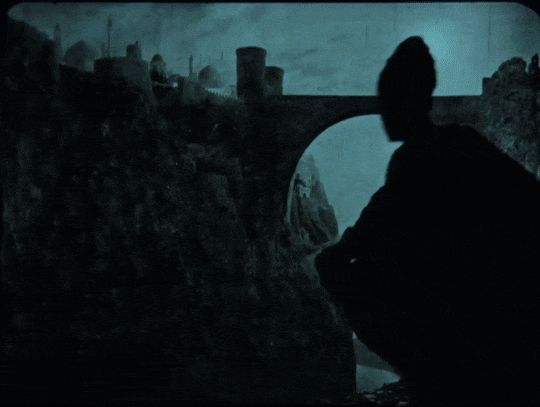
see all gifs here
Earle, knowing that traditional stills could not be taken while filming, brought in Edward S. Curtis. Curtis developed techniques in still photography to replicate the look of the photographic effects used for the film. So, even though the film hasn’t survived, we have some pretty great looking representations of some of the 1000s of missing feet of the film.

Nearly a year before Curtis joined the crew, Earle began collaboration with composer Charles Wakefield Cadman. In another bold creative move, Cadman and Earle worked closely before principal photography began so that the score could inform the construction and rhythm of the film and vice versa.
By the end of 1921 the film was complete. After roughly 9 months and the creation of over 500 paintings, The Rubaiyat was almost ready to meet its public. However, the investors in The Rubaiyat, Inc., the corporation formed by Earle to produce the film, objected to the ample reference to wine drinking (a comical objection if you’ve read the poems) and wanted the roles of the young lovers (played by as yet unknown Ramon Novarro and Kathleen Key) to be expanded. The dispute with Earle became so heated that the financiers absconded with the bulk of the film to New York. Earle filed suit against them in December to prevent them from screening their butchered and incomplete cut. Cadman supported Earle by withholding the use of his score for the film.
Later, Eastern Film Corp. brokered a settlement between the two parties, where Earle would get final cut of the film and Eastern would handle its release. Earle and Eastern agreed to change the title from The Rubaiyat of Omar Khayyam to simply Omar. Omar had its first official preview in New York City. It was tentatively announced that the film would have a wide release in the autumn.
However, before that autumn, director Norman Dawn launched a dubious patent-infringement suit against Earle and others. Dawn claimed that he owned the sole right to use multiple exposures, glass painting for single exposure, and other techniques that involved combining live action with paintings. All the cited techniques had been widespread in the film industry for a decade already and eventually and expectedly Dawn lost the suit. Despite Earle’s victory, the suit effectively put the kibosh on Omar’s release in the US.
Earle moved on to other projects that didn’t come to fruition, like a Theda Bara film and a frankly amazing sounding collaboration with Cadman to craft a silent-film opera of Faust. Omar did finally get a release, albeit only in Australia. Australian news outlets praised the film as highly as those few lucky attendees of the American preview screenings did. The narrative was described as not especially original, but that it was good enough in view of the film’s artistry and its imaginative “visual phenomena” and the precision of its technical achievement.
One reviewer for The Register, Adelaide, SA, wrote:
“It seems almost an impossibility to make a connected story out of the short verse of the Persian of old, yet the producer of this classic of the screen… has succeeded in providing an entertainment that would scarcely have been considered possible. From first to last the story grips with its very dramatic intensity.”
While Omar’s American release was still in limbo, “Ramon Samaniegos” made a huge impression in Rex Ingram’s Prisoner of Zenda (1922, extant) and Scaramouche (1923, extant) and took on a new name: Ramon Novarro. Excitement was mounting for Novarro’s next big role as the lead in the epic Ben-Hur (1925, extant) and the Omar project was re-vivified.
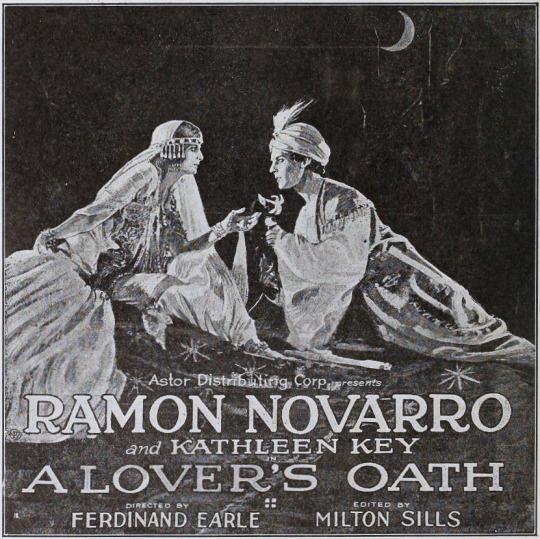
A new company, Astor Distribution Corp., was formed and purchased the distribution rights to Omar. Astor hired actor (note, not an editor) Milton Sills to re-cut the film to make Novarro and Key more prominent. The company also re-wrote the intertitles, reduced the films runtime by more than ten minutes, and renamed the film A Lover’s Oath. Earle had moved on by this point, vowing to never direct again. In fact, Earle was indirectly working with Novarro and Key again at the time, as an art director on Ben-Hur!
Despite Omar’s seemingly auspicious start in 1920, it was only released in the US on the states rights market as a cash-in on the success of one of its actors in a re-cut form five years later.
That said, A Lover’s Oath still received some good reviews from those who did manage to see it. Most of the negative criticism went to the story, intertitles, and Sills’ editing.
What kind of legacy could/should Omar have had? I’m obviously limited in my speculation by the fact that the film is lost, but there are a few key facts about the film’s production, release, and timing to consider.
The production budget was stated to be $174,735. That is equivalent to $3,246,994.83 in 2024 dollars. That is a lot of money, but since the production was years long and Omar was a period film set in a remote locale and features fantastical special effects sequences, it’s a modest budget. For contemporary perspective, Robin Hood (1922, extant) cost just under a million dollars to produce and Thief of Bagdad (1924, extant) cost over a million. For a film similarly steeped in spectacle to have nearly 1/10th of the budget is really very noteworthy. And, perhaps if the film had ever had a proper release in the US—in Earle’s intended form (that is to say, not the Sills cut)—Omar may have made as big of a splash as other epics.
It’s worth noting here however that there are a number of instances in contemporary trade and fan magazines where journalists off-handedly make this filmmaking experiment about undermining union workers. Essentially implying that that value of Earle’s method would be to continue production when unionized workers were striking. I’m sure that that would absolutely be a primary thought for studio heads, but it certainly wasn’t Earle’s motivation. Often when Earle talks about the method, he focuses on being able to film things that were previously impossible or impracticable to film. Driving down filming costs from Earle’s perspective was more about highlighting the artistry of his own specialty in lieu of other, more demanding and time-consuming approaches, like location shooting.
This divide between artists and studio decision makers is still at issue in the American film and television industry. Studio heads with billion dollar salaries constantly try to subvert unions of skilled professionals by pursuing (as yet) non-unionized labor. The technical developments of the past century have made Earle’s approach easier to implement. However, just because you don’t have to do quite as much math, or time an actor’s movements to a metronome, does not mean that filming a combination of painted/animated and live-action elements does not involve skilled labor.
VFX artists and animators are underappreciated and underpaid. In every new movie or TV show you watch there’s scads of VFX work done even in films/shows that have mundane, realistic settings. So, if you love a film or TV show, take the effort to appreciate the work of the humans who made it, even if their work was so good you didn’t notice it was done. And, if you’ve somehow read this far, and are so out of the loop about modern filmmaking, Disney’s “live-action” remakes are animated films, but they’ve just finagled ways to circumvent unions and low-key delegitimize the skilled labor of VFX artists and animators in the eyes of the viewing public. Don’t fall for it.
VFX workers in North America have a union under IATSE, but it’s still developing as a union and Marvel & Disney workers only voted to unionize in the autumn of 2023. The Animation Guild (TAG), also under the IATSE umbrella, has a longer history, but it’s been growing rapidly in the past year. A strike might be upcoming this year for TAG, so keep an eye out and remember to support striking workers and don’t cross picket lines, be they physical or digital!
Speaking of artistry over cost-cutting, I began this post with a mention that in the early 1920s, the American film industry was developing an inferiority complex in regard to its own artistry. This was in comparison to the European industries, Germany’s being the largest at the time. It’s frustrating to look back at this period and see acceptance of the opinion that American filmmakers weren’t bringing art to film. While yes, the emergent studio system was highly capitalistic and commercial, that does not mean the American industry was devoid of home-grown artists.
United Artists was formed in 1919 by Douglas Fairbanks, Charlie Chaplin, Mary Pickford, and D.W. Griffith precisely because studios were holding them back from investing in their art—within the same year that Earle began his Omar project. While salaries and unforgiving production schedules were also paramount concerns in the filmmakers going independent, a primary impetus was that production/distribution heads exhibited too much control over what the artists were trying to create.
Fairbanks was quickly expanding his repertoire in a more classical and fantastic direction. Cecil B. DeMille made his first in a long and very successful string of ancient epics. And the foreign-born children of the American film industry, Charlie Chaplin, Rex Ingram, and Nazimova, were poppin’ off! Chaplin was redefining comedic filmmaking. Ingram was redefining epics. Nazimova independently produced what is often regarded as America’s first art film, Salome (1923, extant), a film designed by Natacha Rambova, who was *gasp* American. Earle and his brother, William, had ambitious artistic visions of what could be done in the American industry and they also had to self-produce to get their work done.
Meanwhile, studio heads, instead of investing in the artists they already had contracts with, tried to poach talent from Europe with mixed success (in this period, see: Ernst Lubitsch, F.W. Murnau, Benjamin Christensen, Mauritz Stiller, Victor Sjöström, and so on). I’m in no way saying it was the wrong call to sign these artists, but all of these filmmakers, even if they found success in America, had stories of being hired to inject the style and artistry that they developed in Europe into American cinema, and then had their plans shot down or cut down to a shadow of their creative vision. Even Stiller, who tragically died before he had the opportunity to establish himself in the US, faced this on his first American film, The Temptress (1926, extant), on which he was replaced. Essentially, the studio heads’ actions were all hot air and spite for the filmmakers who’d gone independent.

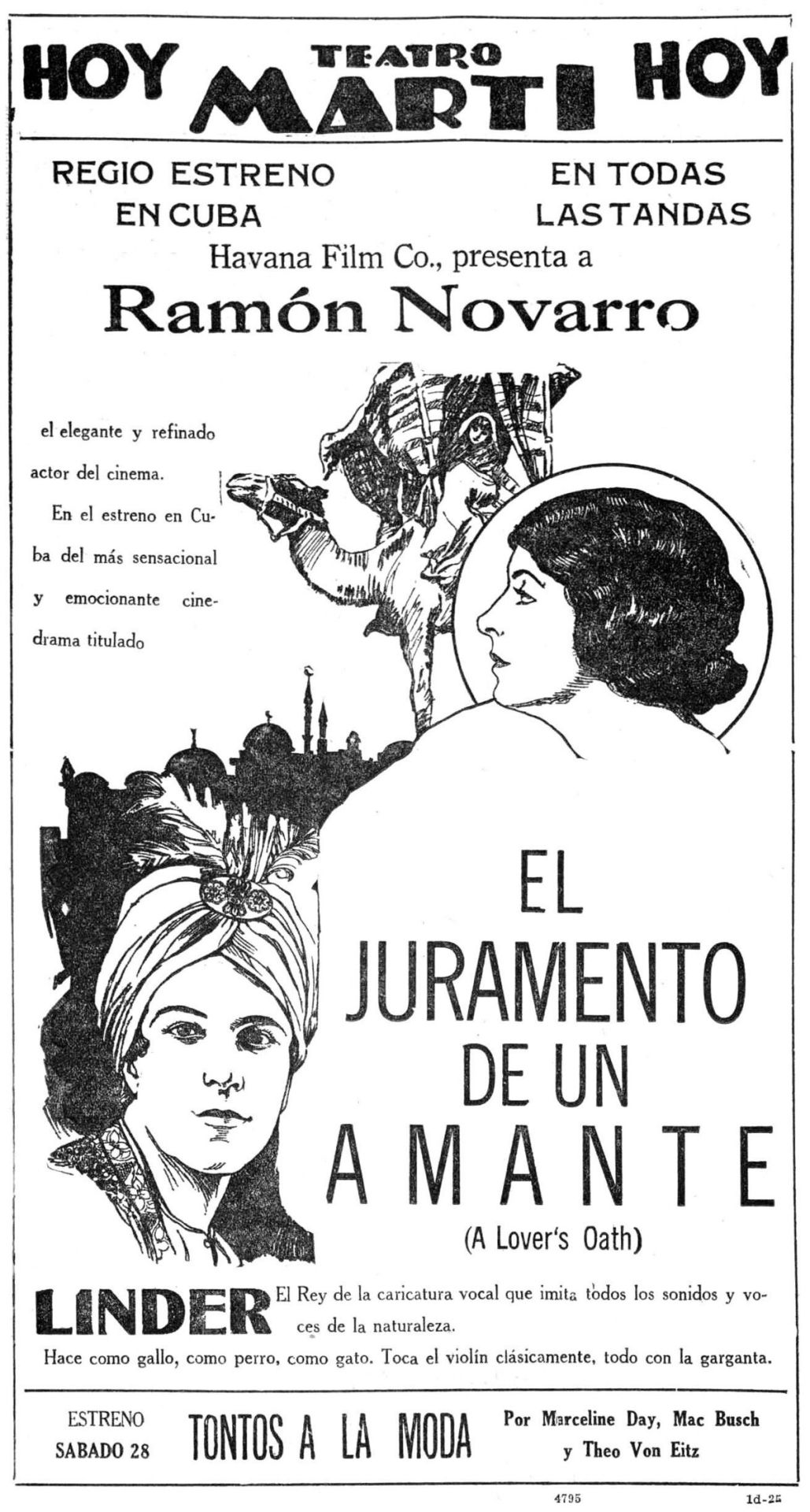
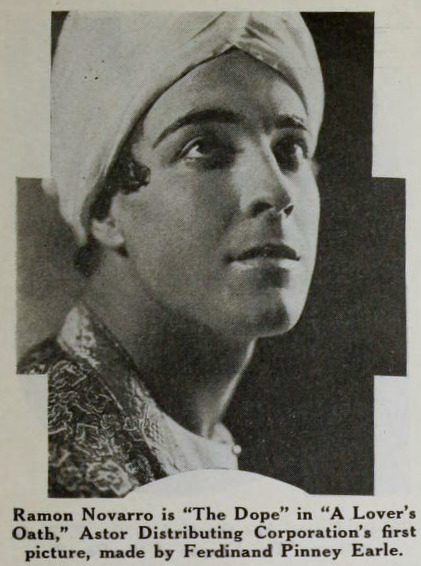
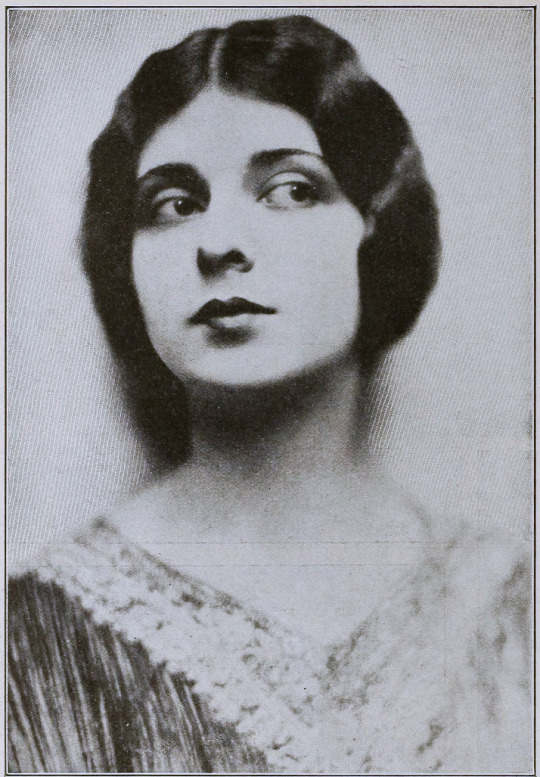
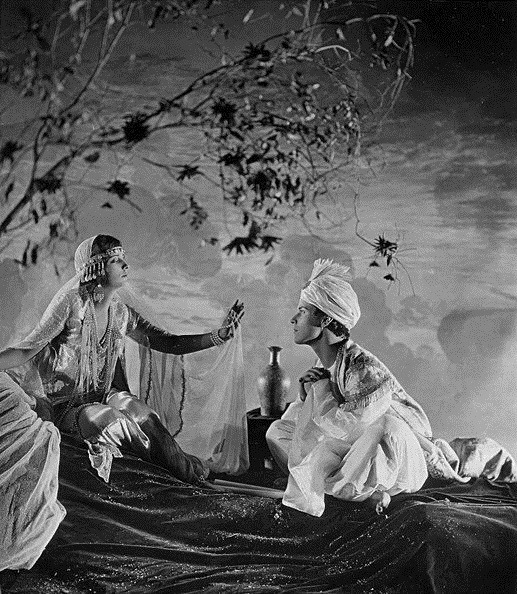
Finally I would like to highlight Ferdinand Earle’s statement to the industry, which he penned for from Camera in 14 January 1922, when his financial backers kidnapped his film to re-edit it on their terms:
MAGNA CHARTA
Until screen authors and producers obtain a charter specifying and guaranteeing their privileges and rights, the great slaughter of unprotected motion picture dramas will go merrily on.
Some of us who are half artists and half fighters and who are ready to expend ninety per cent of our energy in order to win the freedom to devote the remaining ten per cent to creative work on the screen, manage to bring to birth a piteous, half-starved art progeny.
The creative artist today labors without the stimulus of a public eager for his product, labors without the artistic momentum that fires the artist’s imagination and spurs his efforts as in any great art era.
Nowadays the taint of commercialism infects the seven arts, and the art pioneer meets with constant petty worries and handicaps.
Only once in a blue moon, in this matter-of-fact, dollar-wise age can the believer in better pictures hope to participate in a truely [sic] artistic treat.
In the seven years I have devoted to the screen, I have witnessed many splendid photodramas ruined by intruding upstarts and stubborn imbeciles. And I determined not to launch the production of my Opus No. 1 until I had adequately protected myself against all the usual evils of the way, especially as I was to make an entirely new type of picture.
In order that my film verison [sic] of the Rubaiyat of Omar Khayyam might be produced under ideal conditions and safeguarded from intolerable interferences and outside worries, I entered into a contract with the Rubaiyat, Inc., that made me not only president of the corporation and on the board of directors, but which set forth that I was to be author, production manager, director, cutter and film editor as well as art director, and that no charge could be made against the production without my written consent, and that my word was to be final on all matters of production. The late George Loane Tucker helped my attorney word the contract, which read like a splendid document.
Alas, I am now told that only by keeping title to a production until it is declared by yourself to be completed is it safe for a scenario writer, an actor or a director, who is supposedly making his own productions, to contract with a corporation; otherwise he is merely the servant of that corporation, subject at any moment to discharge, with the dubious redress of a suit for damages that can with difficulty be estimated and proven.
Can there be any hope of better pictures as long as contracts and copyrights are no protection against financial brigands and bullies?
We have scarcely emerged from barbarism, for contracts, solemnly drawn up between human beings, in which the purposes are set forth in the King’s plainest English, serve only as hurdles over which justice-mocking financiers and their nimble attorneys travel with impunity, riding rough shod over the author or artist who cannot support a legal army to defend his rights. The phrase is passed about that no contract is invioliable [sic]—and yet we think we have reached a state of civilization!
The suit begun by my attorneys in the federal courts to prevent the present hashed and incomplete version of my story from being released and exhibited, may be of interest to screen writers. For the whole struggle revolves not in the slightest degree around the sanctity of the contract, but centers around the federal copyright of my story which I never transferred in writing otherwise, and which is being brazenly ignored.
Imagine my production without pictorial titles: and imagine “The Rubaiyat” with a spoken title as follows, “That bird is getting to talk too much!”—beside some of the immortal quatrains of Fitzgerald!
One weapon, fortunately, remains for the militant art creator, when all is gone save his dignity and his sense of humor; and that is the rapier blade of ridicule, that can send lumbering to his retreat the most brutal and elephant-hided lord of finance.
How edifying—the tableau of the man of millions playing legal pranks upon men such as Charles Wakefield Cadman, Edward S. Curtis and myself and others who were associated in the bloody venture of picturizing the Rubaiyat! It has been gratifying to find the press of the whole country ready to champion the artist’s cause.
When the artist forges his plowshare into a sword, so to speak, he does not always put up a mean fight.
What publisher would dare to rewrite a sonnet of John Keats or alter one chord of a Chopin ballade?
Creative art of a high order will become possible on the screen only when the rights of established, independent screen producers, such as Rex Ingram and Maurice Tourneur, are no longer interferred with and their work no longer mutilated or changed or added to by vandal hands. And art dramas, conceived and executed by masters of screen craft, cannot be turned out like sausages made by factory hands. A flavor of individuality and distinction of style cannot be preserved in machine-made melodramas—a drama that is passed from hand to hand and concocted by patchworkers and tinkerers.
A thousand times no! For it will always be cousin to the sausage, and be like all other—sausages.
The scenes of a master’s drama may have a subtle pictorial continuity and a power of suggestion quite like a melody that is lost when just one note is changed. And the public is the only test of what is eternally true or false. What right have two or three people to deprive millions of art lovers of enjoying an artist’s creation as it emerged from his workshop?
“The Rubaiyat” was my first picture and produced in spite of continual and infernal interferences. It has taught me several sad lessons, which I have endeavored in the above paragraphs to pass on to some of my fellow sufferers. It is the hope that I am fighting, to a certain extent, their battle that has given me the courage to continue, and that has prompted me to write this article. May such hubbubs eventually teach or inforce a decent regard for the rights of authors and directors and tend to make the existence of screen artisans more secure and soothing to the nerves.
FERDINAND EARLE.
---
☕Appreciate my work? Buy me a coffee! ☕
Transcribed Sources & Annotations over on the WMM Blog!
See the Timeline for Ferdinand P. Earle's Rubaiyat Adaptation
#1920s#1923#1925#omar khayyam#ferdinand pinney earle#ramon novarro#independent film#american film#silent cinema#silent era#silent film#classic cinema#classic movies#classic film#film history#history#Charles Wakefield Cadman#cinematography#The Rubaiyat#cinema#film#lost film
50 notes
·
View notes
Text
Hi,
I make period drama style gifs. If you use gif packs, please like and reblog them.
Unfortunately, business transactions via PayPal are not available in my country, which makes it impossible to purchase GIF packs on Payhip.com. If you would like to purchase a GIF pack, please send the amount to [email protected]. Also, make sure to include the name of the GIF pack you want in a personal message, and I will send it to you via email.
Most of my projects are already ready, but every day I post no more than 190 gifs. Because that was the reason why my previous account was blocked. I tried to make gif packs in a format more familiar to you with a link to a separate page. However, unfortunately, I did not succeed because of the large format of high-quality gifs.
I want to explain about color processing. Usually, I improve the contrast, brightness and saturation, but leave the naturalness of the film. I don't make the contours too sharp because I like the aesthetic of it looking like a natural image.
Actors in alphabetical order: part 1(A-D), part 2, part 3
Navigation
The arrangement of names may not be alphabetical
▶Page 1
Anne Hathaway Anya Taylor-Joy Asia Argento Astrid Berges-Frisbey Boran Kuzum Camille Rutherford
▶Page 2
Carla Juri César Domboy Callum Turner Cate Blanchett Charity Wakefield Charlie Rowe Chiara Mastroianni Christian Bale Christoph Waltz
▶Page 3
Dagmara Dominczyk Dan Stevens Ella Purnell Emily Blunt Ezra Miller Raffey Cassidy Rebecca Emilie Sattrup Rose Byrne Roxane Duran
▶Page 4
Frances O'Connor Gemma Arterton Hannah Taylor-Gordon Hattie Morahan Hugh Dancy Isabelle Adjani Jude Law Keira Knightley
▶Page 5
Izzy Meikle-Small James Norton Jane Birkin Joanne Whalley Lucy Boynton Jim Caviezel Monica Keena Nicolas Duvauchelle Sally Hawkins
▶Page 6
Adriana Tarábková Dakota Fanning Elle Fanning Gaia Weiss Gwyneth Paltrow Kirsten Dunst Léa Seydoux Pia Degermark Roxane Mesquida Rosamund Pike Samantha Gates Sophia Myles Nell Tiger Free
▶Page 7
Annabelle Wallis Austin Butler Carey Mulligan Guy Pearce James Frain Katie Parker Kate Siegel Olivia Cooke Rachel Hurd-Wood Soko Sujaya Dasgupta Tom Cruise
▶Page 8
Adèle Exarchopoulos Anna Maxwell Martin Charles Dance Emma Williams Gillian Anderson Ian Somerhalder Imogen Poots Matthew Rhys Natalie Press Nina Dobrev Paul Wesley Tamzin Merchant
▶Page 9
Anna Friel Catherine Mouchet Déborah François Dominic West Frédéric Noaille Joséphine Japy Kevin Kline María Valverde Paz Vega
▶Page 10
Ben Whishaw Clémence Poésy Elliot Grihault Emilia Fox Joseph Morgan Lambert Wilson Michelle Dockery Phoebe Fox Sophie Okonedo Tom Hiddleston Tom Hughes Tom Sturridge
▶Page 11
Calista Flockhart Charlotte Gainsbourg Christina Giannelli David Strathairn Felicity Jones Fu'ad Aït Aattou Greta Scacchi Helena Bonham Carter Holliday Grainger Michelle Pfeiffer Rupert Friend Sophie Marceau
▶Page 12
Angela Bassett Brooke Carter Cillian Murphy Danylo Kolomiiets Katie McGrath Keeley Hawes Maria Bonnevie Marta Gastini Miriam Giovanelli Olivia Hussey Oscar Isaac Peter Plaugborg
▶Page 13
Ben Affleck Ben Barnes Ben Chaplin Bill Skarsgård Iben Akerlie Jakob Oftebro Jo Woodcock Josh Hartnett Lily-Rose Depp Reese Witherspoon Ruth Wilson Samantha Soule Taissa Farmiga Tess Frazer Virginie Ledoyen
▶Page 14
Cary Elwes Colin Firth Daniel Day-Lewis Emilia Verginelli Hannah James Jonah Hauer-King Loli Bahia Lorenzo Balducci Rebecca Hall Robin Wright Rupert Everett Willa Fitzgerald
▶Page 15
Annes Elwy Claire Danes Eliza Scanlen Freddie Fox Hugh Jackman Kathryn Newton Louis Partridge Maya Hawke Romola Garai Samantha Mathis Trini Alvarado Winona Ryder
▶Page 16
Douglas Smith Eric Bana Gizem Karaca Jessica Brown Findlay Kenneth Branagh Kit Harington Millie Brady Natalie Dormer Poppy Delevingne Rachel Weisz Rosy McEwen Sam Claflin
▶Page 17
Aubri Ibrag Christina Hendricks Connie Jenkins-Greig Guy Remmers Henry Cavill Imogen Waterhouse Josie Totah Mia Threapleton Olivia Hallinan
▶Page 18
Alex Fitzalan Emma Connell Essie Davis Fahriye Evcen Justine Waddell Natalia Sánchez Monica Bellucci Penelope Cruz Piper Perabo
▶Page 19
Alicia Vikander Alida Baldari Calabria Christopher Abbott Emma Stone Jasmine Blackborow Kim Rossi Stuart Lili Reinhart Louis Cunningham Margaret Qualley Marine Vacth Mark Ruffalo Mélanie Thierry Ramy Youssef Scarlett Johansson Sydney Sweeney
▶Page 20
Antonia Clarke Cameron Monaghan Daisy Edgar-Jones Domhnall Gleeson Heather Graham Isolda Dychauk Kaitlyn Dever Karen Gillan Laoise Murray Madelaine Petsch Olivia Colman Sophie Turner Vanessa Redgrave
▶Page 21
Claire Foy Claire Holt Clementine Nicholson Emily Mortimer Jennifer Beals Kelly Macdonald Lena Headey Perdita Weeks Ruta Gedmintas Sarah Bolger Sting Tom Holland
▶Page 22
Berrak Tuzunatac Burcu Ozberk Cansu Dere Deniz Cakir Melisa Sozen Merve Bolugur Saadet Aksoy Yasemin Allen
▶Page 23
Alesya Romanova Alina Kovalenko Anastasiya Ostreinova Anna Sagaydachnaya Dorota Delag Konstantin Temlyak Kseniya Mishina Marianna Januszewicz Oleksii Yarovenko Olena Lavrenyuk Taras Tsimbalyuk Veronika Shostak
▶Page 24
Amelia Warner Bruce Robinson Cristiana Capotondi Christiane Filangieri David Rott Francesca Annis Golshifteh Farahani Helen McCrory Maisie Williams Nadia Parkes Pierre Niney Uma Thurman
▶Page 25
To do list:
Christopher Gorham under development (The Other Side of Heaven 2001) Harry Melling - The Pale Blue Eye 2022 Nora Arnezeder - Angélique 2013 Isabella Heathcote - Pride and Prejudice and Zombies. Dark Shadows 2012. Beneath Hill 60 2010. Eleanor Worthington-Cox in Gwen (2018) Julie Delpy - La passion Béatrice 1987, Frankenstein 2004, Trois couleurs: Blanc 1994, The Three Musketeers 1993 Nastassja Kinski - Revolution (1985), Tess 1979 Julia Ormond - Young Catherine 1991, First Knight 1995, Legends of the Fall 1994 Laura Donnelly - Beowulf: Return to the Shieldlands, Britannia, Outlander Morena Baccarin in Stargate Isabella Celani - A Room with a View 1985 Neve McIntosh - Gormenghast 2000 Kate Beckinsale - Much Ado About Nothing 1993 Sarah Felberbaum as Maddalena in Medici Rocco Gottlieb - The Book of Vision 2020 Kate Beckinsale - Alice Through the Looking Glass 1998. Stonehearst Asylum 2014. Haunted 1995. Royal Deceit 1994. Love & Friendship 2016. Van Helsing 2004. Pearl Harbor 2001. Michelle Jenner - La catedral del mar 2018, Isabel Aaron Taylor-Johnson - Anna Karenina 2012. Nosferatu 2024. Oskar McNamara
Volker Bohnet — Ludwig 1973 Romy Schneider — Ludwig 1973, Sissi 1955 Helmut Berger — Ludwig 1973
✦Ethan Erickson
Dorian 2003— under development
All of these gifs were made from scratch by me for roleplaying purposes. Feel free to use them as sidebars and reaction gifs. PLEASE DON’T CLAIM THEM AS YOUR OWN.

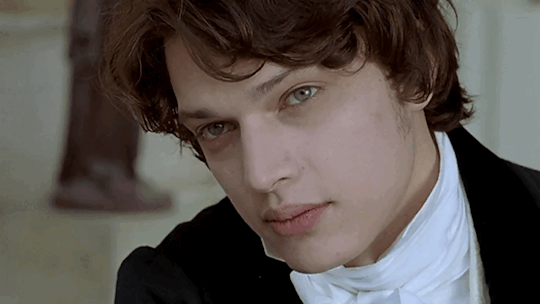

39 notes
·
View notes
Text

Keith Dewhurst
Writer for stage and screen whose work included the TV police series Z-Cars and several plays at the National Theatre and Royal Court
The journalist turned playwright and screenwriter Keith Dewhurst, who has died aged 93, was part of an extraordinary informal ensemble of actors, designers and musicians who collaborated for more than a decade with the inspirational director Bill Bryden.
Members of this group worked first with Bryden in the Royal Court’s Theatre Upstairs in 1970, and later at the National Theatre when Bryden was invited by Peter Hall to let rip on plays by Eugene O’Neill and David Mamet, as well as on two promenade performances in the NT’s Cottesloe (now the Dorfman) theatre, scripted by Dewhurst and the poet Tony Harrison.
Harrison’s ebullient, idiomatic version of the Wakefield Mystery plays – The Mysteries (Brian Glover as God in a flat cap on a fork-lift truck) – started on Easter Saturday in 1977, and was followed by Dewhurst’s glorious adaptation, in two plays (1978-79), of Flora Thompson’s elegiac Lark Rise to Candleford, an account of an agrarian village community in Oxfordshire in the pre-industrial 1880s.
Bryden’s irregulars on Lark Rise included Glover, Dinah Stabb, Edna Doré and Jack Shepherd, the designer William Dudley – evoking vistas of wheatfields at harvest time, stars and bleakness in winter on an overhanging sky cloth – and the electric folk rock of the Albion Band with the singer Martin Carthy from Steeleye Span.
Dewhurst’s magical adaptation of Thompson’s trilogy of novels threw shadows of enclosure and poverty around the quotidian joys and back-bending work of the community. The overall effect was one of deep and poetic poignancy, sometimes akin to Jean-François Millet’s painting of The Gleaners.
He and Bryden complemented this success with a more ecstatically political and vivid version of the historian Christopher Hill’s account of ideological turmoil in the English civil war, The World Turned Upside Down (1978); and, on the NT’s Olivier stage in 1982, Paul Scofield as Don Quixote, in which he made a glorious rendition of the epic grandeur in Cervantes’ picaresque novel. The Don’s trusty steed, Rocinante, was a knackered old penny-farthing tricycle, suitable for a nostalgist of knight errantry.
Dewhurst’s fifth and final show at the National was a fleet and funny adaptation of Mikhail Bulgakov’s Black Snow in 1991, sharpening the fangs of the novel’s backstage bitchery after the author, writing in the 30s, had fallen out of love with the Moscow Art theatre. The director was William Gaskill who, as artistic director at the Royal Court, had first ratified Dewhurst’s and Bryden’s connection.
Dewhurst had preceded this illustrious career as a football reporter on the Manchester Evening Chronicle in the 1950s, detailed to follow the fortunes of Manchester United, then in the flowering of the Busby Babes era. He became a trusted insider at the club, and indeed chronicler, before and after the Munich air disaster in 1958, when United’s plane had stopped for refuelling on the way back from a European cup-tie in Belgrade, then crashed on take-off.
A close colleague on the Chronicle, Alf Clarke, was one of many journalists and players among the 23 who were killed. The team’s manager, Matt Busby, and fledgling star Bobby Charlton were among the survivors, and Dewhurst was on hand to recount the trauma and extraordinary recovery the club made on a tide of nationwide grief and sentiment.
Born in Oldham, Lancashire, Keith was the son of Joseph Dewhurst, who worked in the cotton industry, and Lily (nee Carter). He was educated at Rydal school in Colwyn Bay – where he had been evacuated during the war – and Peterhouse, Cambridge, where he graduated with a degree in English in 1953.
He worked for a while as a yarn tester for the Lancashire Cotton Corporation in Cheshire before joining the Chronicle in 1955, but he was determined to branch out. By the early 1960s he was writing plays for television and radio, which led to an important association with the radical new police series Z-Cars in 1968, and its sequel, Softly Softly: Task Force in 1971. And he wrote a dramatic biographical TV play for The Edwardians BBC series about David Lloyd George (1974), with Anthony Hopkins in the title role.
He had married the actor Eve Pearce in 1958 and moved to London in 1967. From 1969 he worked for a year as an arts columnist on the Guardian. His first theatre play in the capital was Rafferty’s Chant (1967) at the Mermaid, a farce involving a Mancunian conman selling the same car to a string of dupes, before he linked with Bryden on a single Sunday night epic production (without decor), Pirates, at the Royal Court in 1970.
This was the seed of the Bryden/Dewhurst collaboration, followed by the 1809 face-off between French and English soldiers in Corunna!, both with Steeleye Span – Maddy Prior and Carthy to the fore – prominent.
The battle of Corunna! was mind-blowing in the Theatre Upstairs, too big for its military boots, and the first expression of Bryden’s radical, extravagant musical style. Dewhurst went with him in 1972 to the Edinburgh Lyceum to write feisty new adaptations of Robert Louis Stevenson’s Kidnapped and Molière’s The Miser.
His fine television writing continued with 27 episodes of Richmal Crompton’s Just William (1977-78), with Bonnie Langford as Violet Elizabeth Bott and Diana Dors as her mother; and two television movies adapted from Alexandre Dumas – The Man in the Iron Mask (1985) and a voiced cartoon of The Three Musketeers (1986).
His two notable movies were Chris Thomson’s The Empty Beach (1985), a thriller adapted from a novel by the Australian author Peter Corris; and David Leland’s The Land Girls (1998), adapted from a novel by Angela Huth about the women’s land army in Dorset during the second world war, with three new shooting stars: Rachel Weisz, Anna Friel and Steven Mackintosh.
He continued writing into his 90s, including several novellas as well as two books on football and a theatrical memoir with Shepherd. He also contributed regularly to the Manchester United fanzine, United We Stand.
Dewhurst and Pearce had two daughters, Emma and Faith, and a son, Alan, who died in 2023. The marriage ended in divorce in 1980 and, in the same year, Dewhurst married the Australian literary agent Alexandra Cann, with whom he lived in Fulham, south-west London, and latterly on the Isle of Wight. She survives him, along with his daughters and three grandchildren, Henry, Alex and Millie.
🔔 Keith Frederick Dewhurst, playwright, screenwriter and journalist, born 24 December 1931; died 11 January 2025
Daily inspiration. Discover more photos at Just for Books…?
4 notes
·
View notes
Text
youtube
Charles Wakefield Cadman (1881-1946) - Legend of the Canyon, Op. 68 Romance for Violin and Piano (1920) Dedication: Fritz Kreisler
1. Peter Zazofsky, violin and Paul Posnak, piano (0:00)
2. The Mont Alto Motion Picture Orchestra (4:09)
6 notes
·
View notes
Text
top portrayals:
LIZZY
[12] Lily James
[9] Keira Knightley, Jennifer Lawrence
[5] Imogen Poots
[4] Maisie Williams
[3] Sarah Bolger, Jenna Louise Coleman, Romola Garai, Bella Heathcote, Amber Heard, Saoirse Ronan, Emily VanCamp, Alicia Vikander
[2] Rose Byrne, Nina Dobrev, Taissa Farmiga, Sarah Gadon, Karen Gillan, Eva Green, Rosie Huntington-Whiteley, Anna Kendrick, Katie McGrath, Leighton Meester, Sophie Turner
[5] Matthew Goode, Jared Padalecki
[4] Jude Law, Aaron Paul
[3] Nathaniel Buzolic, Bradley Cooper, Hugh Dancy, John Krasinski, Landon Liborion, Miles Teller
[2] Jonas Armstrong, Justin Bartha, Douglas Booth, Thomas Brodie-Sangster, Sam Claflin, Charlie Cox, Chace Crawford, Charlie Day, Leonardo DiCaprio, Robert Downey Jr., Martin Freeman, Ryan Gosling, Tom Hardy, Tom Hiddleston, Charlie Hunnum, Jake Johnson, Harry Lloyd, James McAvoy, Mads Mikkelsen, Julian Morris, Colin Morgan, David Morrisey, Dylan O’Brien, Evan Peters, Michael Pitt, Eddie Redmayne, Andrew Scott, Bill Skarsgard, Ben Whishaw
KATE THE GREAT
[ 3 ] Astrid Berges-Frisby, Bella Heathcote [ 2 ] Sarah Gadon, Felicity Jones
KATE AA
[ 8 ] Michael Fassbender [ 8 ] Keira Knightley [ 7 ] Tom Hardy
[ 6 ] Emilia Clarke, Phoebe Tonkin [ 6 ] Jensen Ackles, Richard Armitage, Henry Cavill
[ 5 ] Emily Blunt, Nina Dobrev [ 5 ] Nathaniel Buzolic, Sam Claflin, Luke Evans, Chris Hemsworth
[ 4 ] Jenna Louise Coleman, Michelle Dockery, Margot Robbie, Emma Watson [ 4 ] Ben Barnes, Benedict Cumberbatch, Chris Evans, Liam Hemsworth, Jared Padalecki, Bill Skarsgard, Sebastian Stan, Toby Stevens
[ 3 ] Candace Accola, Natalie Dormer, Jessica Brown Findaly, Claire Holt, Scarlett Johanson, Freya Mavor, Katie McGrath, Natalie Portman, Charlize Theron, Emma Watson [ 3 ] Robert Carlyle, Nikolai Coster-Waldau, Jaime Dornan, Theo James, Joseph Morgan, Julian Morris, Evan Peters, Aidan Turner
[ 2 ] Chloe Bennet, Shelley Hennig, Lena Headey, Amber Heard, Lily James, Leighton Meester, Emilie de Ravin, Krysten Ritter, Sophie Turner, Evan Rachel Wood [ 2 ] Aneurin Barnard, Douglas Booth, Charlie Cox, Charles Dance, Hugh Dancy, Scott Eastwood, Mark Gatiss, Tom Hiddleston, Michiel Huisman, Harry Lloyd, Richard Madden, James Norton, Colin O’Donoghue, Daniel Sharman, Milo Ventimiglia
LAUREN
[ 7 ] Natalie Dormer [ 6 ] Romola Garai [ 5 ] Emma Stone [ 4 ] Crystal Reed, Holland Roden [ 3 ] Karen Gillan, Rosamund Pike, Emilie de Ravin, Eleanor Tommilson, Charity Wakefield
TINA RAE
[ 5 ] Ben Whishaw [ 3 ] Billie Piper [ 3 ] Dylan O’Brian, Colin O'Donoghue [ 2 ] Alexis Bledel, Laura Carmicheal, Sarah Paulson, Lara Pulver, Taylor Swift, Anna Torv [ 2 ] JJ Field, Freddie Highmore, Josh Hutcherson, Gabriel Mann, Dan Stevens, Max Theriot
JENN
2: Cava Delevingne, Zoey Deutch, Phoebe Tonkin, Lea Seydoux, Kristen Stewart, Suki Waterhouse, Emma Watson
3: Tom Hiddleston 2: Daane Dehann, Chris Hemsworth, Luke Mitchell
5 notes
·
View notes
Text

Saint of the day August 22
ST. TIMOTHEUS,ROMAN MARTYR ON THE VIA OSTIENSE,
ST. SYNFORIANUS, MARTYR OF AUTUN,
St. John Kemble, 1679 A.D. One of the Forty Martyrs of England and Wales. He was born in Herefordshire, England, in 1599, and studied at Douai, where he was ordained in 1625. Returning to England, John labored in missions for fifty-three years. At the age of eighty-one, he was arrested at Pembridge Castle, the home of his brother. He was falsely charged in the Titus Oates Plot and condemned for being a Catholic. He was hanged, drawn, and quartered at Hereford. Pope Paul VI canonized him in 1970.
St. John Wall, 1679 A.D. One of the Forty Martyrs of England and Wales. He was born near Preston, England, and was educated at Douai and Rome and ordained in 1645. In 1651 he became a Franciscan, called Father Joachim of St. Anne, returning to Worcester, England, in 1656. There he was arrested in December 1678 and imprisoned for five months. He was martyred by being hanged, drawn, and quartered at Redhill. Pope Paul VI canonized him in 1970.
Bl. Richard Kirkman, 1582 A.D. English martyr. Born in Addingham, Yorkshire, he left England and studied at the famous Catholic school of Douai, France, the preparatory institution for English Catholics who would then return home and work for the reconversion of the isle. Ordained in 1579, in Reims, he sailed to England and served as a tutor for Richard Dymake’s family in Scrivelsby. Richard then went to Yorkshire and Northumberland and he was arrested near Wakefield. He was hanged, drawn, and quartered near York with Blessed William Lacey, on August 22, for denying the supremacy of Queen Elizabeth I as head of the Church of England
Bl. William Lacey, 1582 A.D. Martyr of England. Born in Horton, West Riding, Yorkshire, he distinguished himself as a lawyer and as an ardent Catholic, using his house as a refuge for the much oppressed Catholics of the time. Following the death of his second wife in 1579, he left England and studied at Reims, France, in preparation for his eventual ordination at Rome. William returned to England and worked in the area of Yorkshire until his arrest. He was arrested in York Prison while participating in the Eucharistic ceremony being sung in the cell of Blessed Thomas Bell. Condemned, he was executed at Knavesmaire, just outside of York with Blessed Richard Kirkman. William was beatified in 1886.
St. Gunifort. A martyr of Pavia, Italy. He was Irish, Scottish, or English.
St. Sigfrid. Sigfrid, who died in the year 690, was a deacon at Wearmouth Abbey. He was known for his knowledge of scripture and for his frail health. He was elected coadjutor abbot in 688 on the death of St. Erstwine while Abbot St. Benedict Biscop was in Rome. Sigfrid died soon after St. Benedict.
St. Andrew the Scot, 877 A.D. Archdeacon and companion of St. Donatus. Andrew and his sister, St. Bridget the Younger, were born in Ireland of noble parents. They were educated by St. Donatus, and when Donatus went on a pilgrimage to Italy, Andrew accompanied him. In Fiesole, through a miracle, Donatus was elected bishop. Andrew was ordained the archdeacon of Fiesole, serving Donatus for fortyseven years. He also founded a monastery in Mensola, Italy. Andrew died shortly after Donatus, but his sister, St. Bridget the Younger, was carried by an angel to his bedside, all the way from Ireland.
St. Arnulf, 9th century. Hermit, venerated at Arnulphsbury or Eynesbury, in England.
St. Ethelgitha. Benedictine abbess of Northumbria, England.
St. Antoninus (died 186) was a public executioner in Rome. It is believed that during the trial of St Eusebius he had a vision and converted to Christianity. The proclamation of faith cost his life and he was beheaded in 186. His feast day is 22 August.
ST. PHILIP BENIZI, PRIEST OF THE SERVANTS OF MARY
2 notes
·
View notes
Text
List of Your Ten Childhood Ships
Thanks @lizzybeth1986 for tagging me. So I’m counting childhood as “before high school” so up until spring of 1997. I am an 80s baby, who was a 90s child (and a 90s/00s teenager, but that is a list for another time).
1. Zack and Kelly, Saved by the Bell

Saved by the Bell was one of my favourite shows in my tweens and I had a big crush on Zack Morris (yeah, he was blonde but the cocky, scheming type has always had appeal). I loved Zack and Kelly together and consistently rooted for them.
2. Jake and Tiffany, California Dreams
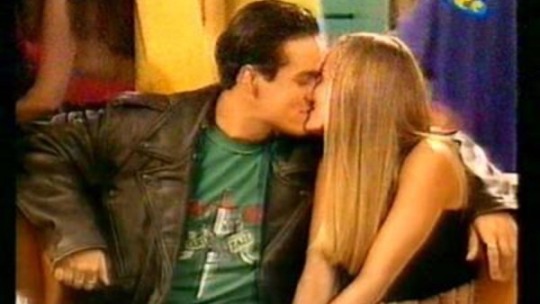
I watched a lot of Teen NBC when I was young 😂 and of course I liked the leather-jacket, motor-cycle wearing musician and his cute blonde surfer girlfriend. I feel like Jake Summers had a major impact on my taste for the rest of my life.
3. Lir and Amalthea, The Last Unicorn

This movie broke my heart at the age of 4. I always joke that this is what made me a villain lover, because I hated how Lir being a hero meant he had to give up Amalthea and let her save the unicorns 😂.
4. Sony and Brenda, General Hospital
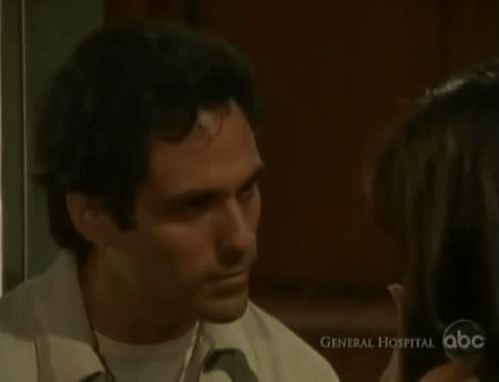
I grew up watching soap operas, mainly General Hospital because it is the one my grandmother and then my mom watched. While Sonny and Brenda definitely influenced my teen ships years, they also influenced the pre-teen years and ai couldn’t resist this combo. “Why settle for a spark when you can set the world on fire?”
5. Anne and Gilbert, Anne of Green Gables

I am a Canadian girl, I grew up on the Anne books and I fell in love early with the spirited Anne Shirley and the incredibly patient (but not pushy) Gilbert Blythe. I love their love story.
6. Elizabeth Wakefield and Todd Wilkins, Sweet Falley High
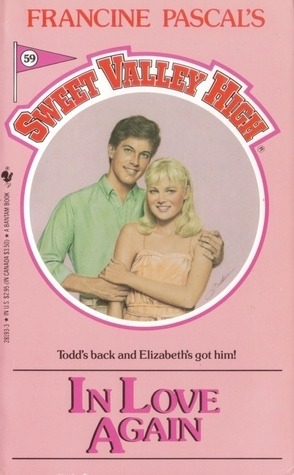
This one did not hold up 😂 and the series itself did a good job of murdering this ship, but when I was a kid I loved them together and the one where he comes back after moving was my favorite. I remember I even specially ordered it because our local book story didn’t have it and neither did the library.
7. Cher and Josh, Clueless
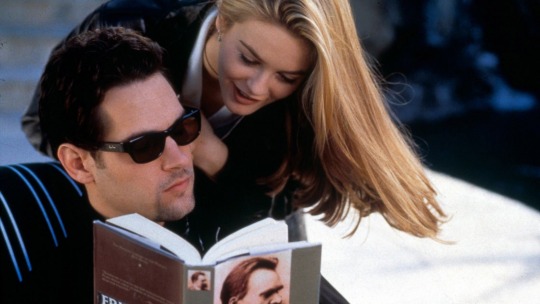
I love Clueless, it is one of my all-time favorite movies and definitely influenced pre-teen Misha. Is the step-sibling romance a little weird? Yep. But at the time, all I cared about was the chemistry and that Paul Rudd was cute.
8. Westley and Buttercup, The Princess Bride

Again, I was an 80s child. I grew up on this movie. This is what true love was. And ok, the fact that the far:boy went off and became a bad-ass pirate was pretty cool.
9. Xena and Ares, Xena Warrior Princess

This is one that also falls into “high school” ships, but I started watching the show in elementary school, so it counts. I fell in love with Ares the first time he appeared, when he was very obviously the bad guy.
10. Sabrina and Harvey, Sabrina the Teenage Witch
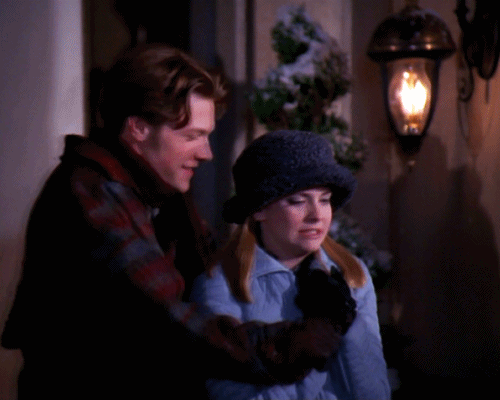
I just thought these two were so sweet together (see I have layers, I like sweet ships too) and I liked that the obstacle in their relationship was never their feelings, it was everything else and Harvey was just such a perfect first boyfriend.
Honorable Mention: Blossom and Vinnie, Blossom
Tagging @jerzwriter @the-unconquered-queen @ladysophiebeckett @boneandfur @walkerismychoice @liliplayschoices @brightpinkpeppercorn @shynmighty @countessogilvy @hellomynameisdevi
20 notes
·
View notes
Text
CHARACTER DUMP.

park sungyu: vinte e quatro anos, estudante de medicina veterinária.fc: oh sehun.
kang dawon: vinte e seis anos, idol (main vocal e visual do nevaeh). fc: joy.
seo hoyeon: vinte e nove anos, dono de uma escola de artes. fc: lee dohyun.
daniela rivera: vinte e dois anos, estudante de biomedicina. fc: isabela merced.
avery malhotra: vinte e seis anos, ex-bailarina e estudante de literatura inglesa. fc: simone ashley.
son haseul: vinte e seis anos, atriz. fc: krystal jung.
melina durmaz: vinte e seis anos, garçonete e fotógrafa. fc: bahar sahin.
nam sunmi: vinte e quatro anos, estudante de moda & administração. fc: go minsi.
aaron jenkins: trinta e cinco anos, arquiteto. fc: richard madden.
harper wakefield: trinta e dois anos, detetive. fc: lily james.
min eunhye: vinte e quatro anos, modelo. fc: moon gayoung.
astrid handler: dezoito anos, estudante de hogwarts e monitora da lufa-lufa. fc: olivia scott welch.
daniel yang: vinte e oito anos, funcionário em uma empresa de roupas. fc: suho.
margo kang: vinte e cinco anos, aspirante a atriz. fc: kim jisoo.
madeleine hawthorne: vinte e um anos, estudante de pré-medicina. fc: madelyn cline.
victor alexander musgrave: vinte e sete anos, duque de devonshire. fc: paul mescal.
heath crawford: vinte e quatro anos, ator. fc: archie renaux.
emre özdemir: trinta anos, roteirista. fc: alperen duymaz.
erik bergström: vinte e três anos, drüskelle. fc: evan roderick.
leonard schultz: trinta anos, músico (vocalista, guitarrista e líder da the guess). fc: fabien frankel.
beatrice willa zhang: vinte e sete anos, enfermeira. fc: jessie mei li.
viviana rossi: vinte e oito anos, atriz da broadway. fc: simona tabasco.
robert cole driscoll: trinta e nove anos, cirurgião ortopédico. fc: chris evans.
lawrence stokes: trinta e dois anos, jogador do san francisco 49ers (running back). fc: keith powers.
marina sampaio: vinte e cinco anos, jogadora de vôlei na seleção dos estados unidos. fc: alba baptista.
charlie gibson: vinte e seis anos, veterinário. fc: corey mylchreest.
connor dempsey: vinte e oito anos, dono do the king’s head. fc: mike faist.
elizabeth ehrmantraut: trinta e três anos, herdeira e acionista da egm (ehrmantraut global media). fc: riley keough.
elaine stewart: vinte e três anos, estudante de cinema. fc: alisha boe.
1 note
·
View note
Text
My father and my mother were high school sweethearts. Whether by coincidence or because she followed him there, they ended up at the same university. After babysitting homeschooled children while they were dating and growing wary of the culture’s lies, she refused to marry my father unless he fully supported her decision to homeschool her future children. And he agreed.
They did mission work in Central America for a time, before deciding to come back to the US to raise and educate their children. Not long after having my brother, and possibly in my lifetime, my father became the object of a female coworker’s attention. She wished to travel in the same vehicle with him and sleep in the same hotel rooms, with constant flirty behavior. There were (and still are) no state laws for workplace sexual harassment where he had placed his family. However, since the trips in question would have brought them across state lines, he might have been able to lawyer up and sue her for “harassment” in federal court. But he didn’t. Instead, he showed her grace while putting up boundaries, and maintained a completely professional relation with her until she was transferred to a different department and never spoke with him again. Throughout all this, my mother remained the sole object of his affection. He did not have to resort to the nuclear option in order to prove his loyalty to her. This remains my model of both loyalty to one’s spouse and how to deal with colleagues who wish to lure the faithful into sin.
I was late for several milestones due to poisoning in the well water at our house. We do not know what metals caused this; mercury would have manifested differently and lead would have a more permanent effect. Whatever the case, I was misdiagnosed with a developmental delay, and due to the happy accident of Andrew Wakefield’s fraudulent study, I was put on the expensive therapy that is chelation. This would have been around the time my sister was born, and my brother was not even four years old, all in one of the poorest areas of the US. Dad had to pick up two jobs just to keep us afloat. Because he agreed to marry Mom under the condition that she homeschooled, her picking up a full-time job was out of the question. I have seen many men in similar situations have affairs or develop addictions. Dad did neither. He was irritable, and took it out on us maybe a few too many times, as he was never taught how to properly handle his anger. I would not, however, describe his behavior as abusive, and he has never once hit Mom. All things considered, he was under pressures far more immense than I can even conceptualize. He modeled loyalty to my mother, respect for the particulars of his marriage covenant, kindness to his family, and devotion to his calling during a period of great sanctification.
Eventually he found a job that would keep all five of us fed and allow him to pay off his remaining debts. Mom developed various spending and saving habits to make sure that we could survive if anything ever occurred to bring them back to a previous state. Various other female colleagues would make advances on him, but he spoke in a manner bordering on obsession about “the Mrs.” and how wonderful of a woman she actually was. They had arguments, some quite heated, but he took the words of Paul the Apostle seriously, “Do not let the sun go down on your anger.” He never promised not to get angry, or even to avoid an explosive temper, but when he realized the damage he had done, he worked to make things right with those whom he had wronged. He modeled regret, remorse, and justice.
Eventually, after all of us were grown, my dad “quit.” That is legally what happened, anyway. In reality, two people my mom unabashedly describes as sociopaths came to view Dad as an enemy, and backstabbed him. He decided to quit and take the stipend before they had time to mar his resume. I was a semester and some change from graduating and my brother was already completely moved out, but my sister was a few years away from completing her degree and my mom had not worked in almost twenty years. He spent a good five months looking for work, which put him in a panic, wondering how to feed and house Mom and put my sister through the rest of her time at school. He did and said some crazy things. At the end of it, he was able to relax after finding a job that was suitable for his needs. Though he was not stable during that time, his foremost concern was my mom and sister. This was the most recent major test of his quality as a husband and father, and he definitely proved himself worthy. It was fortunately a remote job, as he got it about three weeks after news stories hit of a virus spreading from Wuhan, China. He has kept the same job since, being able to eventually move himself and my mom back to their hometown, living out their lives as empty-nest gulfrats (self-described), and they would not be happier any other way.
Through his thirty-two years as a husband and twenty-seven as a father, Dad had some vices, but he modeled far more virtues. If I get married one day, I will ask his advice often, and already have in order to be the best prospective husband I could be in previous relationships. If I have children of my own, I will ask his advice often, and though my parenting style will not be the exact same, I will take what worked and apply it.
Happy Father’s Day, Dad.
#christian marriage#christian relationships#homeschool#homeschooling#father's day#fathers day#real talk#man talk#men talking to men
7 notes
·
View notes
Note
I just finished the show. This is such a good fucking show!
Even though i am HEARTBROKEN, through Elisabeth, Grigor and Catherine the show really gave the room to sort of process it and by giving that last kick, really got us out of the pain and invested in how she will keep her reign. Truly smart writing. Like with just 10 episodes, they wrote a love story, a heartbreak and a riveting political play, like only The Great can.
I am still definitely broken about Peter's death. I don't know how the show will do whole seasons without him, and very very selfishly wish they don't make another love for Catherine.
When Elisabeth said basically fuck off to Peter the Great, i was in pain, wishing Peter had also said the same. And elisabeths fate of losing two children to water, my god.
Paul will never know how much Peter loved him. Catherine always humming Their Song. Wearing his clothes. Grigor, the true himbo. So Torn by grief he thinks a box is a good place to keep a child. Immersing himself in bath fully clothed? He is i think the most affected because i don't he truly knows how to live without Peter. Also what's up with Marial? I understand but also dude!!!
Charit Wakefield is so good. Her actual pain in losing Peter, sewn with George's intrinsic manipulation, she is good. Amazing. So is Phoebe Fox as Marial and every single person in this cast because otherwise the insanity of this show could never deliver the emotional impact.
I always liked Nicholas Hoult, but after this show i am completely and Fully obsessed with him. I only hope he'll be back as a ghost next season. (But i like that they didn't bring him back this season, it would've hurt too much). Because as you said his and elles chemistry needs to shine more.
Okay as of now, this is all i have for thoughts. Might have more once I start giffing, but until then you are released from the grips of my 1k words long asks.
i agree with you wholeheartedly!! despite the great loss (lol), the show has proven its ability to still excel w/o peter. the last episode is riveting and freeing. it shows precisely why peter needs to be gone for catherine to be great (of course the show will be great focusing on catherine and peter's love story but the great is never about that) people who are mad that they get rid of peter or say that catherine x peter is the whole point of the show don't understand the show at all. i feel like all of the characters (not just catherine) have a chance to develop in a new direction due to peter's death and that gives the show a fresh air/start🫶 and please do keep sending me your thoughts haha <3
8 notes
·
View notes
Text
2024 Independent Games Festival Finalists
Best Student Game
goodbye.monster (Monster Team)
Once Upon a Jester (Bonte Avond / Crunching Koalas)
Pile Up! (Remoob / Catoptric Games, IndieArk)
Planetka (TeTerka)
RAM: Random Access Mayhem (Xylem Studios Inc.)
TRY AGAIN(the Rejects / USC Games/the Rejects)
Honorable Mentions: A Day With Mochi (San Felicete Studio / Rubika Supinfogame), Barkane: The Folds of Calamity (Chase O'Brien & VGDev), Birds Aren't Real: The Game (USC Games), Cyberside Picnic (Michael Luo / Cathode Radiator), Entangled (Fibula Studio), Lime Juice (Benbees), Re:Fresh (Merge Conflict Studio)
Excellence in Audio
A Highland Song (Inkle)
COCOON (Geometric Interactive / Annapurna Interactive)
Nour: Play With Your Food (Terrifying Jellyfish / PANIC)
Rhythm Doctor (7th Beat Games / 7th Beat Games, indienova)
Tchia (Awaceb / Kepler Interactive)
Venba (Visai Games)
Honorable Mentions: Anthology of the Killer (Thecatamites, Tommy Tone, A. Degen / Thecatamites), El Paso, Elsewhere (Strange Scaffold), Let's! Revolution! (Antfood, BUCK / Hawthorn Games, BUCK), Planet of Lana (Wishfully / Thunderful Publishing), Stray Gods: The Roleplaying Musical (Summerfall Studios / Humble Games)
Excellence in Design
Chants of Sennaar (Rundisc / Focus Entertainment)
Cobalt Core (Rocket Rat Games / Brace Yourself Games)
COCOON (Geometric Interactive / Annapurna Interactive)
Cryptmaster (Paul Hart, Lee Williams, Akupara Games / Akupara Games)
Final Profit: A Shop RPG (Brent Arnold)
Isles of Sea and Sky (Cicada Games, Jason Newman, Craig Collver / Cicada Games, Jason Newman, Gamera Game)
Honorable Mentions: 20 Small Mazes (FLEB), Peaks of Yore (Anders Grube Jensen / TraipseWare), Price of Flight (WATERBOX), Timberborn (Mechanistry)
Excellence in Narrative
1000xRESIST (Sunset Visitor / Fellow Traveller)
A Highland Song (Inkle)
Mediterranea Inferno (Lorenzo Redaelli/EYEGUYS / Santa Ragione)
The Cosmic Wheel Sisterhood (Deconstructeam / Devolver Digital)
The Wreck (The Pixel Hunt)
Venba (Visai Games)
Honorable Mentions: Goodbye Volcano High (KO_OP), Saltsea Chronicles (Die Gute Fabrik / Die Gute Fabrik), Slay the Princess (Black Tabby Games), Stray Gods: The Roleplaying Musical (Summerfall Studios / Humble Games) The Archivist and the Revolution (Autumn Chen)
Excellence in Visual Arts
Anthology of the Killer (Thecatamites, Tommy Tone, A. Degen / Thecatamites)
Clash: Artifacts of Chaos (ACE Team / Nacon)
Darkest Dungeon II (Red Hook Studios)
Little Goody Two Shoes (AstralShift / Square Enix Collective)
Phonopolis (Amanita Design)
Venba (Visai Games)
Honorable Mentions: 30 Birds (RAM RAM Games/Business Goose / ARTE France), Chants of Sennaar (Rundisc / Focus Entertainment), Goodbye Volcano High (KO_OP), NIDUS (Caleb Wood), SLUDGE LIFE 2 (Terri Vellmann, DOSEONE / Devolver Digital)
Nuovo Award
1000xRESIST (Sunset Visitor / Fellow Traveller)
Anthology of the Killer (Thecatamites, Tommy Tone, A. Degen / Thecatamites)
Cryptmaster (Paul Hart, Lee Williams, Akupara Games / Akupara Games)
Kevin (1997-2077) (Kevin Du)
Mediterranea Inferno (Lorenzo Redaelli/EYEGUYS / Santa Ragione)
NIDUS (Caleb Wood)
The Forest Cathedral (Wakefield Interactive, Brian Wilson / Whitethorn Games)
Honorable Mentions: BlueSuburbia (alienmelon), goodbye.monster (Monster Team), In Stars and Time (insertdisc5 / Armor Games Inc.), Nour: Play With Your Food (Terrifying Jellyfish / PANIC), The Cosmic Wheel Sisterhood (Deconstructeam / Devolver Digital)
Seumas McNally Grand Prize
1000xRESIST (Sunset Visitor / Fellow Traveller)
A Highland Song (Inkle)
Anthology of the Killer (Thecatamites, Tommy Tone, A. Degen / Thecatamites)
COCOON (Geometric Interactive / Annapurna Interactive)
Mediterranea Inferno (Lorenzo Redaelli/EYEGUYS / Santa Ragione)
Venba (Visai Games)
Honorable Mentions: Chants of Sennaar (Rundisc / Focus Entertainment), Final Profit: A Shop RPG (Brent Arnold), Goodbye Volcano High (KO_OP), In Stars and Time (insertdisc5 / Armor Games Inc.), Rhythm Doctor (7th Beat Games / 7th Beat Games, indienova), Tchia (Awaceb / Kepler Interactive), The Cosmic Wheel Sisterhood (Deconstructeam / Devolver Digital)
5 notes
·
View notes
Video
vimeo
“The Morning Show" Season 02 Main Title from Elastic on Vimeo.
Post Production Design Studio: Elastic
SEASON 02: Creative Directors: Hazel Baird & Angus Wall Design & Animation: Daniel Moreno Editor: Teddy Gersten Producers: Michael Ross Deputy Head of Production: Zach Wakefield Executive Producer: Luke Colson Executive Producer / Head of Production: Kate Berry Managing Director: Jennifer Sofio Hall
SEASON 01: Design Studio: Elastic Creative Directors: Angus Wall & Hazel Baird Design: Emanuele Marani Lead Animators: EJ Kang and Emanuele Marani Animators: Peter Murphy, Erik Righetti, Kenneth Robin, Lucy Kim Editors: Doron Dor, Shawn Fedurchuk Producers: Michael Ross, Paul Makowski Executive Producer: Luke Colson Head of Production: Kate Berry Managing Director: Jennifer Sofio Hall
2 notes
·
View notes